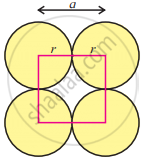Advertisements
Advertisements
Question
Answer the following in brief.
Calculate the packing efficiency of metal crystal that has simple cubic structure.
Solution
Packing efficiency of metal crystal in the simple cubic lattice:

- Step 1: Radius of sphere:
In the simple cubic unit cell, particles (spheres) are at the corners and touch each other along the edge.
A face of a simple cubic unit cell is shown in the figure.
From the figure, we can find that
a = 2r or r = `"a"/2` ......(1)
where, ‘r’ is the radius of atom and ‘a’ is the length of the unit cell edge. - Step 2: Volume of sphere:
Volume of a sphere = `4/3π"r"^3`.
Substitution for r from equation (1) gives:
Volume of one particle = `4/3π ("a"/2)^3` = `(pi"a"^3)/6` ....(2) - Step 3: Total volume of particles:
Because a simple cubic unit cell contains only one particle, the volume occupied by the particle in unit cell =`(pi"a"^3)/6` - Step 4: Packing efficiency:
Packing efficiency = `"Volume occupied by particles in unit cell"/"Total volume of a unit cell" xx 100`
`= (pi"a"^3//6)/"a"^3 xx 100 = (100 pi)/6 = (100 xx 3.142)/6 = 52.36 %`
Thus, in a simple cubic lattice, 52.36 % of total space is occupied by particles and 47.64% is empty space, that is, void volume.
APPEARS IN
RELATED QUESTIONS
Answer the following in one or two sentences.
Which of the three types of packing used by metals makes the most efficient use of space and which makes the least efficient use?
Answer the following in brief.
Cesium chloride crystallizes in a cubic unit cell with Cl– ions at the corners and a Cs+ ion in the center of the cube. How many CsCl molecules are there in the unit cell?
The density of iridium is 22.4 g/cm3. The unit cell of iridium is fcc. Calculate the radius of iridium atom. Molar mass of iridium is 192.2 g/mol.
Aluminium crystallizes in a cubic close-packed structure with a unit cell edge length of 353.6 pm. What is the radius of Al atom? How many unit cells are there in 1.00 cm3 of Al?
An element has a bcc structure with a unit cell edge length of 288 pm. How many unit cells and a number of atoms are present in 200 g of the element? (1.16 × 1024, 2.32 × 1024)
A compound is formed by elements A and B. This crystallizes in the cubic structure when atoms A are at the comers of the cube and atoms B are at the centre of the body. The simplest formula of the compounds is ____________.
Identify the INCORRECT match.
A compound of X and Y crystallizes in ccp structure in which the X atoms occupy the lattice points at the corners of cube and Y atoms occupy the centres of each of the cube faces. The formula of this compound is ____________.
The total volume occupied by particles m simple cubic unit cell is ____________.
The number of particles in 1 g of a metallic crystal is equal to ____________.
The coordination number of each sphere in simple cubic lattice is ____________.
Which of the following contains the highest number of atoms?
The percentage of vacant space of bcc unit cell is ____________.
What is the edge length of fcc type of unit cell having density and atomic mass 6.22 g cm−3 and 60 g respectively?
1 mol of CO2 contains ____________.
Atoms of elements A and B crystallize in hep lattice to form a molecule. Element A occupies 2/3 of tetrahedral voids, the formula of molecule is ______.
What is the percentage of void space in bcc type of in unit cell?
An element crystallizes in a bee lattice with cell edge of 500 pm. The density of the element is 7.5 g cm-3. How many atoms are present in 300 g of metal?
AB is an ionic solid. If the ratio of ionic radius of A+ and B- is 0.52, what is the coordination number of B- ?
The relation between the radius of the sphere and the edge length in the body-centred cubic lattice is given by the formula ______.
Calculate packing efficiency in face-centred cubic lattice.
A compound made of elements C and D crystallizes in a fee structure. Atoms of C are present at the corners of the cube. Atoms of D are at the centres of the faces of the cube. What is the formula of the compound?
